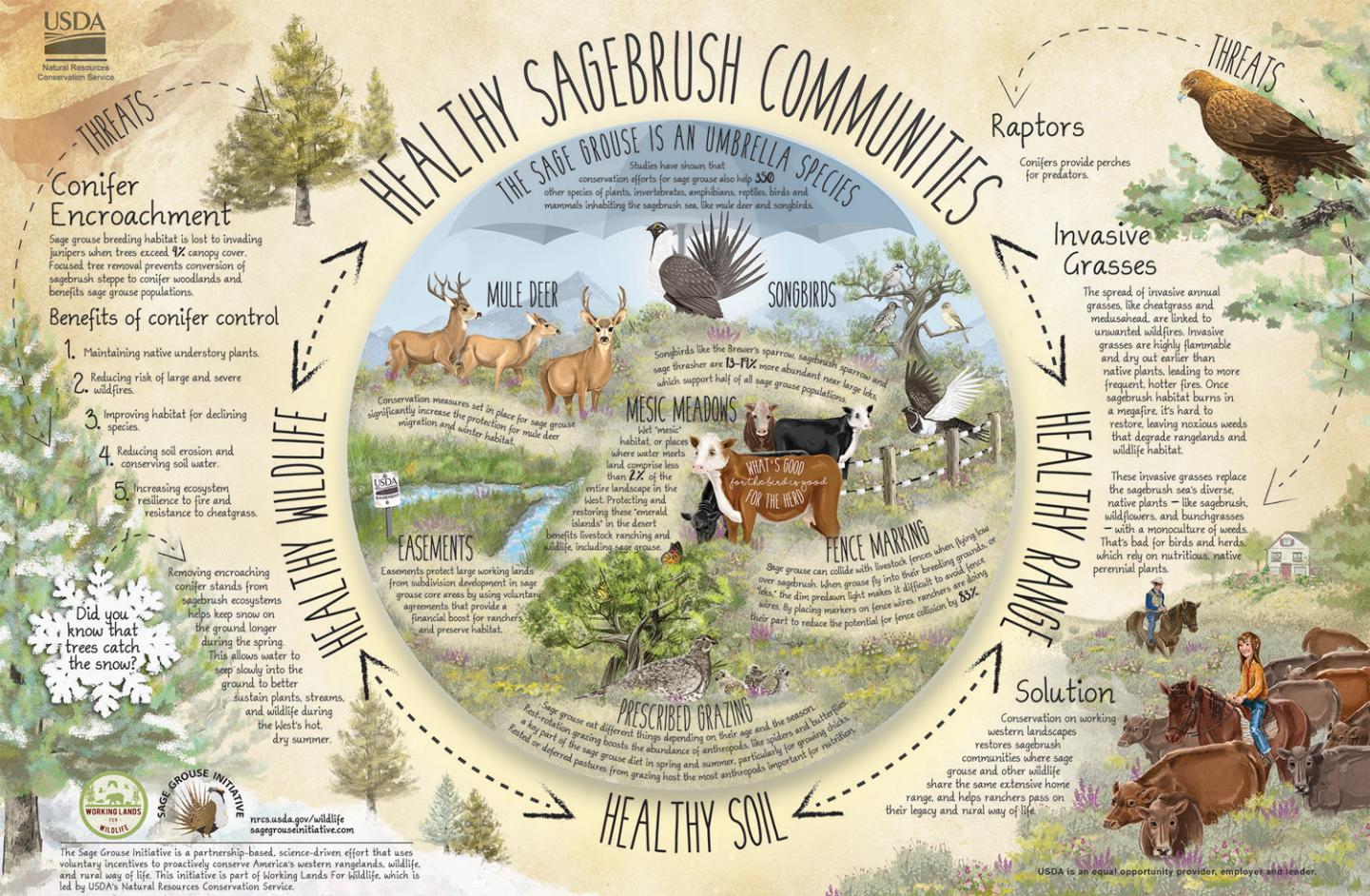
Press Release


The sage grouse, a chicken-like bird uniquely adapted to this habitat, is the poster child of the sagebrush country.
The sage grouse, a chicken-like bird uniquely adapted to this habitat, is the poster child of the sagebrush country and is best known for its early-morning dance during mating season.
Large-scale conversion of native rangelands to cultivated fields, housing and energy developments, invading conifers, and catastrophic wildfires have fragmented this vital landscape, reducing its size by half. And many species, including the sage grouse, have seen substantial declines from historic numbers as a result.
Stewardship-minded ranchers are helping reverse this decline by conserving and enhancing sagebrush habitat. And their conservation practices benefit more than just wildlife. They are improving the long-term sustainability of their grazing lands. As the saying goes, “what’s good for the bird is good for the herd.”

Ranchers are part of a range-wide collaborative effort to voluntarily aid the sage grouse and the sagebrush landscape, an effort credited with enabling the U.S. Fish and Wildlife Service to determine in 2015 that protections under the Endangered Species Act were not needed for the species. NRCS is working with nearly 1,500 landowners in 11 Western states to improve habitat for sage grouse while also improving ranching operations.
NRCS offers technical and financial assistance to help ranchers voluntarily conserve sage grouse habitat on private lands. This assistance helps producers plan and implement a variety of conservation activities, or practices, that benefit the bird and agricultural operations.
The agency’s staff of experts work side-by-side with ranchers to develop a conservation plan. This plan is customized for the rancher’s land and provides a roadmap for how to use a system of conservation practices to meet natural resource and production goals.
Financial assistance helps producers pay for the adoption of conservation practices that improve the health of the sagebrush ecosystem. NRCS assistance covers part of the actual cost. Common conservation practices for the greater sage-grouse include prescribed grazing, removal of invasive conifers, and restoration of wet meadows. Technical assistance is free.
The greater sage-grouse is a nationally identified target species of the Working Lands for Wildlife (WLFW) partnership, a collaborative approach to conserve habitat while keeping working lands working. From 2010 to 2015, the Sage Grouse Initiative (part of the WLFW family) enabled producers to conserve more than 5.6 million acres of prime habitat. By 2018, NRCS aims to conserve 8 million acres. Read our Sage Grouse Initiative 2.0 investment strategy.
Through WLFW, NRCS targets conservation efforts where the returns are highest by targeting threats to the bird. For the greater sage-grouse, the loss and fragmentation of habitat is caused primarily by invading conifers, conversion to cropland or subdivision, and catastrophic wildfires. WLFW is able to provide technical and financial assistance through the Environmental Quality Incentives Program and Agricultural Conservation Easement Program, two programs funded through the Farm Bill, the largest funding source for wildlife habitat conservation on private lands.
Habitat restored for the sage grouse also benefits 350 other sagebrush-dependent species, including songbirds like Brewer’s sparrow and green-tailed towhee, as well as game species like deer and pronghorn. Data show that conservation practices used to improve sage grouse habitat led to population spikes of the green-tailed towhee and Brewer’s sparrow by 81 percent and 55 percent, respectively.
Learn more about sage grouse and other wildlife of the unique but imperiled sagebrush landscape as well as the steps ranchers are taking to restore and protect it by:

Sage Grouse Initiative website
Bringing Healthy Sagebrush Communities Full Circle - Poster and Multimedia Story
Sage Grouse Initiative magazine: Success on the Range
Sage Grouse Initiative 2.0 Investment Strategy
“On the Range, Water Is Life” multimedia story
Science to Solutions report: Sagebrush Songbirds Under the Sage Grouse Umbrella
Contact your local service center to start your application.
Do you farm or ranch and want to make improvements to the land that you own or lease?
Natural Resources Conservation Service offers technical and financial assistance to help farmers, ranchers and forest landowners.

To get started with NRCS, we recommend you stop by your local NRCS field office. We’ll discuss your vision for your land.
NRCS provides landowners with free technical assistance, or advice, for their land. Common technical assistance includes: resource assessment, practice design and resource monitoring. Your conservation planner will help you determine if financial assistance is right for you.
We’ll walk you through the application process. To get started on applying for financial assistance, we’ll work with you:
Once complete, we’ll work with you on the application, or CPA 1200.
Applications for most programs are accepted on a continuous basis, but they’re considered for funding in different ranking periods. Be sure to ask your local NRCS district conservationist about the deadline for the ranking period to ensure you turn in your application in time.
As part of the application process, we’ll check to see if you are eligible. To do this, you’ll need to bring:
If you don’t have a farm number, you can get one from USDA’s Farm Service Agency. Typically, the local FSA office is located in the same building as the local NRCS office. You only need a farm number if you’re interested in financial assistance.
NRCS will take a look at the applications and rank them according to local resource concerns, the amount of conservation benefits the work will provide and the needs of applicants. View Application Ranking Dates by State.
If you’re selected, you can choose whether to sign the contract for the work to be done.
Once you sign the contract, you’ll be provided standards and specifications for completing the practice or practices, and then you will have a specified amount of time to implement. Once the work is implemented and inspected, you’ll be paid the rate of compensation for the work if it meets NRCS standards and specifications.